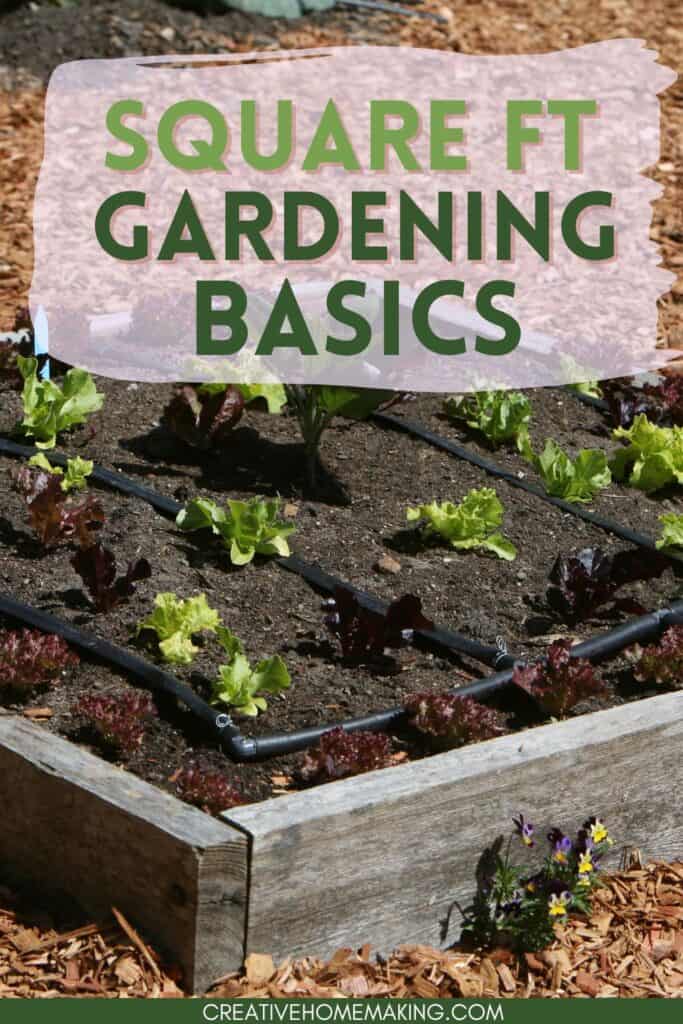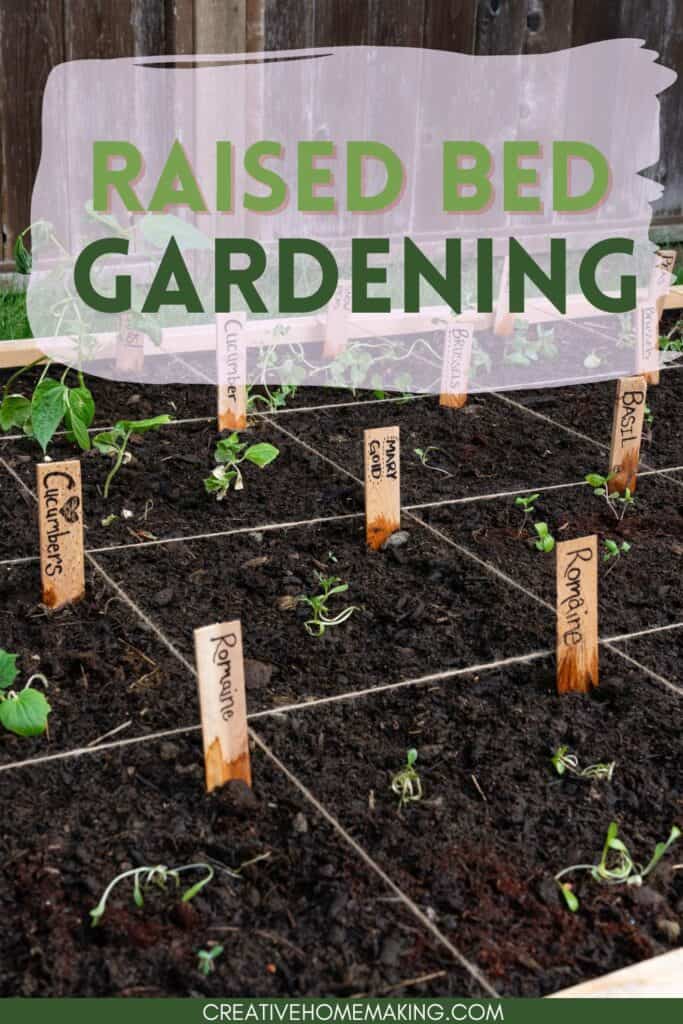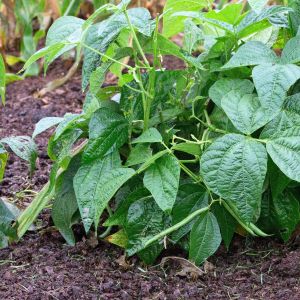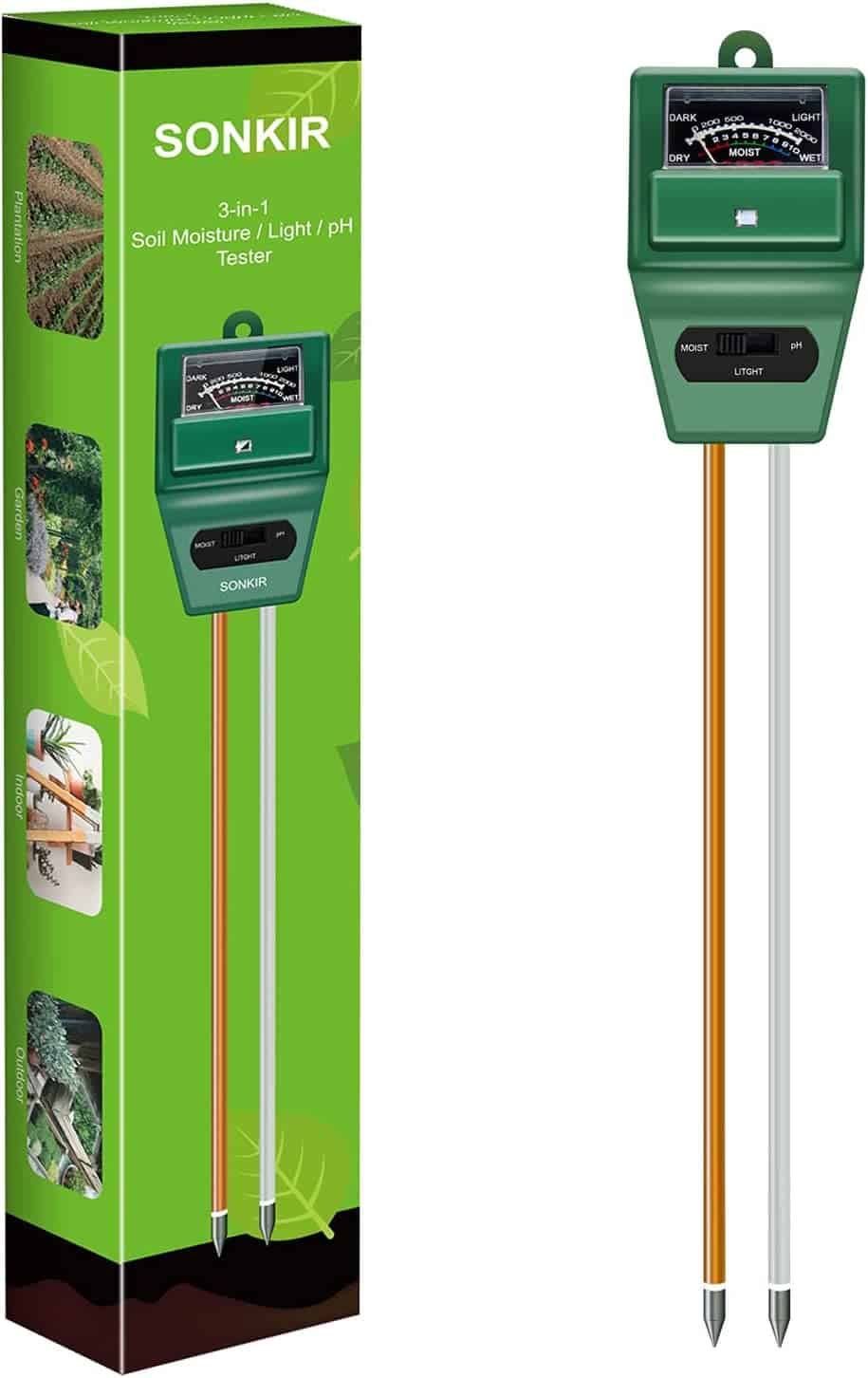If you’re looking to maximize your harvest in a small space, square foot gardening with bush beans is the perfect solution. Bush beans are a popular choice for square foot gardening due to their manageable size, ease of growth, and tasty produce. By incorporating this technique, you can optimize your space and yield a more successful bean crop.
This post may contain affiliate links.
In square foot gardening, you will divide your garden space into 1×1 square foot sections, allowing for strategic planting and space-saving benefits. Bush beans are particularly well-suited for this method, because they don’t require the support of a trellis like their vining counterpart, pole beans.
Related article: How to Freeze Green Beans
Growing bush beans in your square foot garden will help you make the most of your area, while also providing a bountiful harvest for you and your family to enjoy. Keep in mind that bush beans should be planted with no more than four plants per square to ensure ample room for growth.

What Are Bush Beans
Bush beans are a popular variety of beans that are smaller and more compact than their pole bean cousins. As one of the easiest plants to grow, bush beans are well-suited to square foot gardening, making them an excellent choice for beginner gardeners or anyone looking to maximize their limited garden space.
These plants are a type of legume that produces edible seeds, which are typically classified as vegetables. Bush beans are not only delicious, but they’re also packed with nutrients such as protein, fiber, and essential vitamins and minerals.
One key feature that sets bush beans apart from pole beans is their compact growth habit. You’ll find that bush bean plants can thrive without the support of a trellis or any other structures, making them a low-maintenance vegetable to grow in your square foot garden.
Related Article: Pickled Green Beans (Dilly Beans)
When planning your square foot garden, you can grow bush beans quite easily by following the method of planting no more than four plants per square, as they will grow outward. According to the Gardening Elsa website, a good rule of thumb is to plant 10 to 15 bush bean plants per person.
Another advantage of growing bush beans is their relatively short growing season. This means that you can enjoy a harvest of fresh, homegrown beans in a matter of weeks, and even have the opportunity to plant and harvest multiple batches throughout the growing season.
Overall, bush beans can be a perfect addition to your square foot garden, offering high yields, ease of growth, and minimal maintenance. As you design your garden layout and select the right plants, be sure to consider incorporating bush beans into your plan.
Bush Beans Square Foot Gardening Basics
Grid Planning
In square foot gardening, planning is essential. Start by sketching out the layout of your garden on paper to visualize the arrangement of plants. Divide the area into equal square feet (1×1 foot). The number of plants you can fit in each square depends on the size of the plant, as each vegetable has its own spacing requirements.
Related Article: How to Grow Green Beans in Pots: A Beginner’s Guide

Related Article: Canning Green Beans
Arrange your crops based on factors like growth habit, size, sunlight, and water requirements. Be sure to include a path for easy access to all squares. Consider companion planting, as certain plants can support each other’s growth by repelling pests or providing essential nutrients. Plan crop rotation to encourage soil health and prevent disease buildup.
Raised Bed Gardening
Square foot gardening often incorporates raised bed gardening. Raised beds provide several benefits for growing vegetables:
- Improved drainage: Excess water can easily escape, preventing waterlogging.
- Enhanced soil quality: By filling your raised beds with top-quality soil, you can bypass poor native soil conditions.
- Easier maintenance: Raised beds are easier to weed, water, and harvest due to their elevated position.
- Better root growth: The loose soil in raised beds promotes healthy root growth, leading to more productive plants.
To build a raised bed, select the location in your garden with the best sunlight exposure. The ideal size of a square foot garden raised bed is 4×4 feet, as it provides ample room for various crops while maintaining accessibility from all sides. Construct the frame using sturdy materials like wood or composite boards.

Once the frame is in place, fill it with a balanced growing medium of equal parts compost, peat moss, and coarse vermiculite. Finally, add a grid to distinguish the individual square feet, making it easy to organize your planting layout.
Remember to keep your square foot garden tidy and well-maintained, ensuring quality harvests and prolonged plant health. Enjoy the benefits of this gardening technique, and watch your vegetables thrive.
Related Article: Best Green Beans to Grow: Tips for a Bountiful Harvest
Soil Preparation
Before starting your square foot gardening with bush beans, you need to ensure the soil is well-prepared. First select a sunny area for your bush bean plants, as they will need full sunlight to thrive. Then focus on the soil itself.
To create a healthy soil mix, combine equal parts of vermiculite, compost, and peat moss. This mixture is ideal for most vegetables, fruits, and flowers, including bush beans. Vermiculite helps with aeration and drainage, while compost provides essential nutrients and microorganisms for healthy plant growth. Peat moss, on the other hand, retains moisture and keeps the soil from getting compacted.
When tilling or spading your garden, make sure to work the soil to a depth of six to eight inches. This will create a loose, well-drained seed-bed that allows bean roots to stretch rapidly and take in water, food, and oxygen easily. Additionally, ensure the soil is as free as possible from clumps of earth or sod.
Bush beans grow best when the ambient air temperature is in the 65 to 85°F range, and soil temperatures should be between 70 and 80°F for germination. Make sure to check the soil temperature before sowing your bush bean seeds to prevent them from rotting in the ground.
Here are some tips for preparing your bush bean square foot garden:
- Clear the area of any debris or weeds before tilling.
- Amend the soil with compost, peat moss, and vermiculite as needed for fertility and drainage.
- Ensure that your garden soil is loose and well-draining.
- Double-check the soil temperature before sowing seeds to ensure successful germination.
Remember that good soil preparation is crucial for growing healthy and productive bush beans in your square foot garden. Follow these guidelines, and you’ll be on your way to enjoying a bountiful harvest.
Bush Beans Planting Guide
Spacing Requirements
When planting bush beans in your square foot garden, the spacing requirements are crucial for healthy growth. Although some gardeners suggest fitting nine plants in one square foot, this can be too cramped and negatively affect your plants’ health.
A better recommendation is to plant four bush beans per square foot to provide ample space for growth and avoid overcrowding. Ensure there is enough room between plants by placing seeds about 3 inches (7.5 cm.) apart, and if planting in rows, maintain a distance of 18 to 24 inches (46 to 61 cm.) between them.
Timing and Germination
Timing is another essential aspect to consider when planting bush beans. Ensure that the soil temperature is above 60 degrees Fahrenheit before planting seeds. Spring is an ideal season for planting, as the soil temperature generally meets the required warmth.
To prepare your garden for bush beans, consider adding a layer of fresh compost to the top of the soil, and check that the soil pH is above 6.0. Also, choose a location that receives 4 to 6 hours of sunlight per day.
When planting bush bean seeds, plant them 1.5 inches (3.5 cm.) deep into the soil. After sowing, you can expect germination to occur within 1 to 2 weeks. To increase the chances of successful germination, plant two seeds per hole, just in case one doesn’t germinate.
By following these guidelines for spacing, timing, and germination, your bush beans should grow healthily in your square foot garden. Keep an eye on your plants and provide adequate care throughout the growing season to enjoy a bountiful harvest.
Companion Planting
While selecting a bean variety, it’s important to also consider companion planting. This refers to growing different plants close to each other to provide mutual benefits, such as pest control or improved growth. Here are some good companion plants that can be paired with bush beans:
- Corn: Beans and corn thrive together because beans supply nitrogen to the soil, which corn needs to grow.
- Tomatoes: When planted together, tomatoes may deter pests that are attracted to beans while the beans may enhance the flavor of the tomatoes.
- Carrots: The bean plants help to suppress weeds while the carrots break up the soil and create space for the roots of bean plants to grow.
However, not all plants work well with beans. Some plants to avoid in proximity to beans are:
- Onions: This vegetable has a strong aroma that can attract pests to your bean plants.
- Radish: Radishes tend to compete with beans for nutrients and may stunt their growth.
When preparing the soil for your beans and their companion plants, ensure that it’s well-draining and enriched with organic matter. Beans prefer soil temperatures between 70 and 80°F for germination, so make sure to plant the seeds when the conditions are right.
In your square foot garden, arrange your beans and companion plants in a way that allows for easy access while maximizing the benefits they offer to one another. By following these guidelines, you’ll be well on your way to nurturing a thriving and productive bean garden.
Watering and Fertilizing
When it comes to watering your bush beans in a square foot garden, it’s essential to water them deeply but gently to a depth of 4 to 6 inches. This thorough soaking encourages the roots to seek water deep in the soil, allowing the plants to be more resilient during hot, dry weather.
You should avoid watering your bush beans by a set calendar schedule. Instead, monitor the moisture levels in your soil and water when the plants need it. Keep in mind that bush beans thrive best in full sunlight, so ensure they’re receiving enough light throughout the day.
Before planting your beans, amend the soil with compost and fertilizer. You can use either chemical or organic fertilizer, depending on your preference. A 16-16-8 fertilizer is recommended at the time of planting, followed by a 9-59-8 fertilizer applied every 4-6 weeks during the growing season.
Carl Pool BR-61 Plant Food 9-58-8 3 Lbs
It’s important to note that bush beans have the unique ability to convert nitrogen from the air, so they will not require additional nitrogen once planted. As for other nutrients, ensure your soil has a healthy balance of phosphorus, potassium, and trace minerals to support your bush bean plants’ growth.
The pH of your soil can also play a role in bush bean growth. Aim for a pH level between 6.0 and 6.8 for optimal bean development. If your soil’s pH is outside of this range, consider amending it with lime or sulfur to achieve the desired levels. You can test the pH of your soil with an inexpensive soil tester like this one.
Soil pH Meter, MS02 3-in-1 Soil Moisture/Light/pH Tester Gardening Tool Kit
To help your bush beans thrive in a square foot garden, be attentive to watering, ensuring they receive full sun, utilize the appropriate fertilizers, and maintain optimum soil conditions. By doing so, you’ll create a healthy environment for your bush bean plants to grow and produce bountiful harvests.
Pest and Disease Management
When growing bush beans in a square foot garden, it’s essential to be vigilant about pests and diseases. They can quickly decimate your plants, so having a plan in place to manage these issues is crucial.
Avoid using harmful insecticides as they can harm both your plants and beneficial insects. Instead, focus on attracting beneficial insects such as ladybugs and lacewings to your garden. These insects will naturally keep pests like aphids and mites at bay, maintaining a balanced ecosystem in your garden.
Another key aspect of pest and disease management is keeping your garden free of weeds. Weeds compete with your bush beans for nutrients, water, and sunlight, and they can also harbor pests and diseases. Regularly removing weeds makes it more difficult for pests and diseases to establish themselves in your garden.
Fungus and viruses can cause significant damage to your bush beans if left unmanaged. To prevent fungal infections, ensure adequate airflow around your plants by not overcrowding them. Planting four bush beans per square foot is a good spacing guideline to follow. Additionally, water your plants in the morning so the leaves can dry before nighttime, as damp leaves encourage fungal growth.
In the case of a virus, it’s essential to remove and dispose of infected plants immediately to prevent the disease from spreading. Be cautious when handling affected plants, as some viruses can easily spread through touch. Proper hygiene, such as washing your hands and sterilizing your gardening tools, is critical in preventing the spread of viruses.
Regularly monitor your bush bean plants for signs of pests or diseases. Early detection is crucial for effective management, as it allows you to address issues before they get out of hand. By following these guidelines, you can maintain a healthy, productive square foot garden while minimizing the impact of pests and diseases on your bush beans.
Harvesting Bush Beans
Harvesting bush beans takes place after about 40 days. You can harvest several crops per season if you stagger them ten days apart. To harvest, gently hold the bean stem with one hand and use the other hand to pull the bean off the stem. Avoid yanking the bean, as it can damage the plant. The more you harvest from your bush bean plants, the more beans they will produce, so keep picking!
Square foot gardening offers a practical and efficient approach to growing bush beans in your garden. By incorporating this method, you can maximize your beans’ yield while minimizing the space required. Don’t be afraid to experiment with different bean varieties and planting techniques, as growing bush beans in a square foot garden is a rewarding and versatile endeavor. Good luck with your gardening efforts, and may you enjoy a plentiful harvest of tasty bush beans!
Follow my gardening board on Pinterest.




